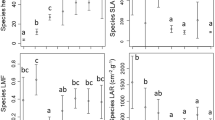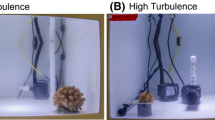Abstract
Photosynthesis, growth, distribution, and persistence of macroalgae are determined in part by the physical environment in which they live. Therefore, discerning how macroalgae interact with their physical environment is necessary to better understand their physiological performance. The purpose of this study was to examine what photosynthetic and hydrodynamic costs and benefits the morphology of Pachydictyon coriaceum (Phaeophyta) confers on the thallus in a given environment. Principal components analysis of morphometric measurements of Pachydictyon coriaceum from different flow habitats and depths separated thalli into three distinct morphs: shallow wave-exposed, shallow wave-protected, and deep. To test the hypothesis that thallus morphology affects net photosynthesis (NP), thalli of three morphotypes of P. coriaceum were incubated in an enclosed recirculating flume under three simulated light/water flow environments representing conditions from which the three morphotypes were collected. The wave-protected and deep morphs had significantly higher rates of photosynthesis than the wave-exposed morph for all three simulated environments. The dense, compact shape of the wave-exposed morph readily streamlines with flow and in doing so, potentially shades many of its internal blades likely accounting for its lower biomass-specific NP. Drag coefficients (C d) were estimated for the three morphotypes over a range of flow velocities between 0.08 and 0.47 m s−1. At lower water flow velocities (0.08–0.21 m s−1), wave-exposed morphs had the lowest C d among the three morphotypes. But drag coefficients of the three morphotypes converged with increasing flow velocities, and at velocities >0.31 m s−1 there were no differences in C d among the three morphotypes. The results of this study indicate that the environmentally-shaped morphs influence photosynthesis and, to a lesser degree, hydrodynamic forces acting on P. coriaceum.





Similar content being viewed by others

References
Abbott IA, Hollenberg GJ (1976) Marine algae of California. Stanford University Press, Stanford
Anderson MS, Charters AC (1982) A fluid dynamics study of seawater flow through Gelidium nudifrons. Limnol Oceanogr 27(3):399–412
Armstrong SL (1989) The behavior in flow of the morphologically variable seaweed, Hedophyllum sessile (C. Ag) Setchell. Hydrobiologica 183:115–122
Bell EC, Denny MW (1994) Quantifying “wave exposure”: a simple device for recording maximum velocity and results from its use at several field sites. J Exp Mar Biol Ecol 181:9–29
Black R (1976) The effects of grazing by the limpet, Acmaea insessa, on the kelp, Egregia laevigata, in the intertidal zone. Ecology 57:265–277
Blanchette CA (1997) Size and survival of intertidal plants in response to wave action: a case study with Fucus gardneri. Ecology 78(5):1563–1578
Blanchette CA, Miner BG, Gaines SD (2002) Geographic variability in form, size and survival of Egregia menziesii around point conception, California. Mar Ecol Prog Ser 239:69–82
Carrington E (1990) Drag and dislodgment of an intertidal macroalga: consequences of morphological variation in Mastocarpus papillatus Kutzing. J Exp Mar Biol Ecol 139:185–200
Cheshire T, Hallam N (1989) Methods of assessing the age composition of native stands of subtidal macro algae. A case study on Durvillaea potatorum. Bot Mar 32:199
Collado-Vides L, Robledo D (1999) Morphology and photosynthesis of Caulerpa (Chlorophyta) in relation to growth form. J Phycol 35:325–330
Denny MW, Daniel TL, Koehl MAR (1985) Mechanical limits to size in wave-swept organisms. Ecol Monog 55:69–102
De Paula EJ, De Oliveira EC (1982) Wave exposure and ecotypical differentiation in Sargassum cymosum (Phaeophyta-Fucales). Phycologia 21:145–153
Doty MS (1971) Measurement of water movement in reference to benthic algal growth. Bot Mar 14:32–35
Druehl LD, Kemp L (1982) Morphological and growth responses of geographically isolated Macrocystis integrifolia populations when grown in a common environment. Can J Bot 60:1409–1413
Dudgeon SR, Johnson AS (1992) Thick vs. thin: algal morphology and tissue mechanics influence differential drag and dislodgment of two co-dominant seaweeds. J Exp Mar Biol Ecol 165:23–43
Enriquez S, Duarte CM, Sand-Jensen K (1995) Patterns in the photosynthetic metabolism of Mediterranean macrophytes. Mar Ecol Prog Ser 119:243–252
Gaillard J, L’Hardy-Halos MT, Pellegrini L (1986) Morphogenèse du Dictyota dichotoma (Huds.) Lamouroux (Phaeophyta). II. Ontogenèse du thalle et cytologie ultrastructurale des differents types de cellules. Phycologia 25:340–357
Gaylord B (2000) Biological implications of surf-zone flow complexity. Limnol Oceanogr 45:174–188
Gaylord B, Blanchette CA, Denny MW (1994) Mechanical consequences of size in wave-swept algae. Ecol Monog 64:287–313
Gerard VA (1987) Hydrodynamic streamlining of Laminaria saccharina Lamour in response to mechanical stress. J Exp Mar Biol Ecol 107:237–244
Gerard VA (1988) Ecotypic differentiation in light-related traits of the kelp Laminaria saccharina. Mar Biol 97:25–36
Gerard VA, Mann KH (1979) Growth and production of Laminaria longicruris (Phaeophyta) populations exposed to different intensities of water movement. J Phycol 15:33–41
Goldsborough WJ, Kemp WM (1988) Light responses of a submersed macrophyte: implications for survival in turbid tidal waters. Ecology 69:1775–1786
Guitierrez LM, Fernandez C (1992) Water motion and morphology in Chondrus crispus (Rhodophyta). J Phycol 28:156–162
Hawes I, Smith R (1995) Effect of current velocity on the detachment of thalli of Ulva lactuca (Chlorophyta) in a New Zealand estuary. J Phycol 31:875–880
Hay ME (1986) Functional geometry of seaweeds: ecological consequences of thallus layering and shape in contrasting light environments. pp 635–666. In: Givnish TJ (ed) On the economy of plant form and function. Cambridge University Press, Cambridge
Hoegh-Guldberg O (1988) A method for determining the surface area of corals. Coral Reefs 7:113–116
Hurd CL, Harrison PJ, Druehl LD (1996) Effect of seawater velocity on inorganic nitrogen uptake by morphologically distinct forms of Macrocystis integrifolia from wave-sheltered and exposed sites. Mar Biol 126:205–214
Hurd CL, Stevens CL, Laval BE, Lawrence GA, Harrison PJ (1997) Visualization of seawater flow around morphologically distinct forms of the giant-kelp Macrocystis integrifolia from wave-sheltered and exposed sites. Limnol Oceanogr 42(1):156–163
Jassby AD, Platt T (1976) Mathematical formulation of the relationship between photosynthesis and light for phytoplankton. Limnol Oceanogr 21:540–547
Jackelman JJ, Bolton JJ (1990) Form variation and productivity of an intertidal foliose Gigartina species (Rhodophyta) in relation to wave exposure. Hydrobiologica 204/205:57–64
Johansson G, Snoeijs P (2002) Macroalgal photosynthetic responses to light in relation to thallus morphology and depth zonation. Mar Ecol Prog Ser 244:63–72
Johnson AS, Koehl MAR (1994) Maintenance of dynamic strain similarity and environmental stress factor in different flow habitats: thallus allometry and material properties of a giant kelp. J Exper Biol 195:381–410
Kawamata S (2001) Adaptive mechanical tolerance and dislodgement velocity of the kelp Laminaria japonica in wave-induced water motion. Mar Ecol Prog Ser 211:89–105
King RJ, Schramm W (1976) Photosynthetic rates of benthic marine algae in relation to light intensity and seasonal variations. Mar Biol 37:215–222
Koehl MAR (1996) When does morphology matter? Annu Rev Ecol Syst 27:501–543
Koehl MAR (1986) Seaweeds in moving water: form and mechanical function. In: Givnish TJ (ed) Ecology of plant form and function. Cambridge University Press, Cambridge, pp 603–634
Koehl MAR, Alberte RS (1988) Flow, flapping, and photosynthesis of Nereocystis luetkeana: a functional comparison of undulate and flat blade morphologies. Mar Biol 99:435–444
Koehl MAR, Wainwright SA (1977) Mechanical adaptations of a giant kelp. Limnol Oceanogr. 22:1067–1071
Kübler JE, Dudgeon SR (1996) Temperature dependent change in the complexity of form of Chondrus crispus fronds. J Exp Mar Biol Ecol 207:15–24
Littler MM, Littler DS (1980) The evolution of thallus form and survival strategies in benthic marine macroalgae: field and laboratory tests of a functional form model. Am Nat 116(1):25–44
Lüning K, Dring MJ (1985) Action spectra and spectral quantum yield of photosynthesis in marine macroalgae with thin and thick thalli. Mar Biol 87:119–129
Milligan KLD, DeWreede RE (2004) Morphological variations do not effectively reduce drag forces at high wave exposure for the macroalgal species, Hedophyllum sessile (Laminariales, Phaeophyta). Phycologia 43:236–244
Nielsen S, Sand-Jensen K (1990) Allometric scaling of maximal photosynthetic growth rate to surface/volume ratio. Limnol and Oceanog 35:177–181
Padilla DK (1993) Rip stop in marine algae: minimizing the consequences of herbivore damage. Evol Ecol 7:634–644
Peckol P, Ramus J (1988) Abundances and physiological properties of deep-water seaweeds from Carolina outer continental shelf. J Exp Mar Biol Ecol. 115:25–39
Perrone C, Felicini GP (1972) Sur les bourgeons adventifs de Pteroglossum nicaeense (Duby) Schotter (Rhodophyta, Gigartinales) en culture. Phycologia 11(1):87–95
Shaughnessy FJ, DeWreede RE, Bell EC (1996) Consequences of morphology and tissue strength to blade survivorship of two closely related Rhodophyta species. Mar Ecol Prog Ser 136:257–266
Sideman EJ, Mathieson AC (1985) Morphological variation within and between natural populations of non-tide pool Fucus distichus (Phaeophyta). New Eng J Phycol 21:250–257
Stewart HL, Carpenter RC (2003) The effects of morphology and water flow on photosynthesis among and within functional form groups of marine macroalgae. Ecology 84(11):2999–3012
Tabachnick BG, Fidell LS (1996) Using multivariate statistics, 3rd edn. HarperCollins College Publishers, New York
Thompson TL, Glenn EP (1994) Plaster standards to measure water motion. Limnol Oceanogr 39(7):1768–1779
Van Alstyne KL (1989) Adventitious branching as a herbivore-induced defense in the intertidal brown alga Fucus distichus. Mar Ecol Prog Ser 56:169–176
Vogel S (1984) Drag and flexibility in sessile organisms. Am Zool 24:37–44
Williams SL, Carpenter RC (1990) Photosynthesis versus light relationships among components of coral reef algal turfs. J Phycol 26:36–40
Acknowledgments
We thank J.P. Lacont, K. Whiteside, C. Walsh, E. Gontang, and S. Grunwald for field and laboratory assistance. A. Park provided map and thallus illustrations. Advice from P. Edmunds, S. Dudgeon, J. Kübler, B. Gaylord, and P. Wilson improved experimental and statistical design. D. James and two anonymous reviewers provided helpful comments. This project was supported in part by grants from the California State University, Northridge Associated Students, PADI Project Aware, and NIH-SCORE (NIH-5S06GM48680-09). Contribution no. 114 from the CSUN Marine Biology Program.
Author information
Authors and Affiliations
Corresponding author
Additional information
Communicated by P.W. Sammarco, Chauvin.
Rights and permissions
About this article
Cite this article
Haring, R.N., Carpenter, R.C. Habitat-induced morphological variation influences photosynthesis and drag on the marine macroalga Pachydictyon coriaceum . Mar Biol 151, 243–255 (2007). https://doi.org/10.1007/s00227-006-0474-2
Received:
Accepted:
Published:
Issue Date:
DOI: https://doi.org/10.1007/s00227-006-0474-2



